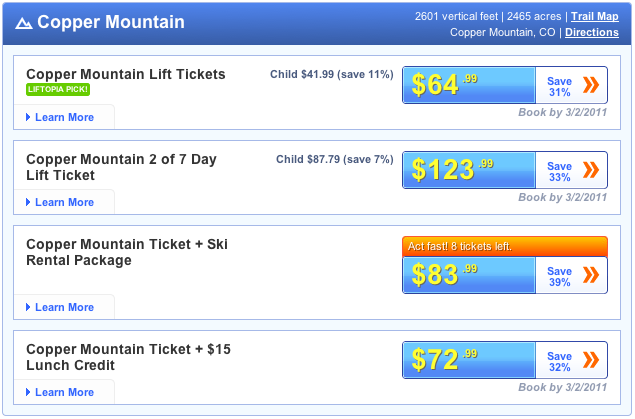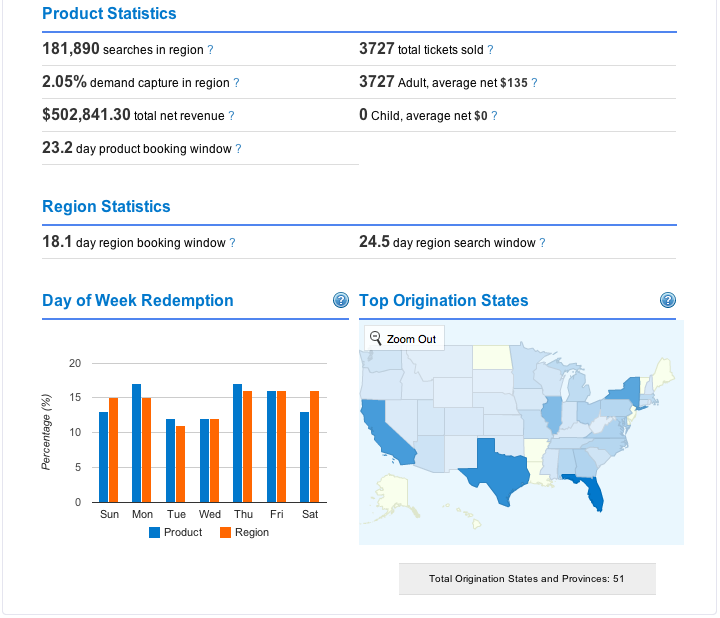How To
Five Tricks for Maximizing Lift Ticket Sales on Liftopia

BLANCHARD

Even after over 150 posts of reviewing, analyzing, and evaluating various tools resorts can use to sell more tickets, I keep coming back to one place: Liftopia. A few weeks back and friend and I snagged a deal for Snowbasin from their site. When I redeemed my pass I took the chance to ask the woman behind the counter how many people were doing so. She enthusiastically responded that it they had started using Liftopia three weeks prior but were already getting more than 25 extra ticket sales a day, a number that was quickly growing.
Combine that with a keep insight into the industry and a commitment to innovation and you’ve got an amazing tool on your hands. During the Super Bowl, a few new tactics resorts were using in their listings caught my eye. Intrigued, I shot co-founder Evan Reece an email to ask him how effective those techniques were. He was willing to share not only that, but also 4 other ways that resorts can make the most of their listings and generate the most sales possible. Take it away Evan…
—
1. Use Variable Pricing

Variable pricing is one of the key components to making the most of this channel. Moving prices around means that resorts can offer value on all days without compromising yield on peak days, and allows them to proactively target times of weak demand. In addition, resorts can reactively address times of weak demand that were not forecasted (rain, cold, gas prices, etc). On the consumer end, variable pricing locks customers in to dates farther in advance, as a deal seen today may not be available if they dont buy right now.
2. Manufacture Scarcity

(aka, strategically limit quantities of tickets at various price points) – When customers do not know when a deal will sell out, they buy farther in advance. Ticket scarcity is equally important to an advance purchase strategy as appropriate pricing. Effectively managing quantities helps to train customers to “act fast” because prices and quantities can change at any time.
3. Load In Advance

When customers buy in advance, resorts lock in revenue and eliminate the “morning of” decision that keeps folks off the hill. Since consumers of leisure tend to aspire to higher levels of consumption when planning in advance, locking them in is especially important. Having tickets available for the entire season means customers book guaranteed revenue into resorts. They also are happy with the value they have purchase when they get to the resort, even when their legs are tired they decide not to ski the second day.
4. Sell Multiple Products

Customers are not one-size-fits-all, which is the primary reason why brands “segment” customers. By offering many product types, whether they be multi-day packages, bundles with rentals, lessons, or even ancillary items like food, resorts can have as many customer segments served as possible. In addition, funny things happen when customers have multiple options. They actually are more likely to make a purchase in the first place, and can be influenced into “buying up” into a premium product. When offering multiple products, make sure to price them appropriately against one another, prioritizing higher value in higher priced options.
5. Data is Your Friend


Making decisions about prices, quantities, products, marketing, distribution, etc are risky if you dont make the most of the data that is available. Keep an eye on things like search volume, demand capture, redemption trends, and the relative performance of various products. Use the tools available alongside your internal data to come up with the right pricing and product decisions for your resort. One of the most important tools is the pricing guidance you can get to help make the best decisions for your success metrics. You may not need to drop your price!
I think it is very important to remember that all resorts are all different, so the recipe for success for one may not be the same for another. As with all marketing, operations, customer service, and distribution decisions – 1. Define success metrics. 2. Come up with a strategy. 3. Execute well. Without defining what success means, how can you come up with a strategy? Without a strategy how can you execute towards that success? And if you don’t execute well, you might as well not undertake the initiative in the first place.
About Gregg & SlopeFillers
I've had more first-time visitors lately, so adding a quick "about" section. I started SlopeFillers in 2010
with the simple goal of sharing great resort marketing strategies. Today I run marketing for resort ecommerce and CRM provider
Inntopia,
my home mountain is the lovely Nordic Valley,
and my favorite marketing campaign remains the Ski Utah TV show that sold me on skiing as a kid in the 90s.
Get the weekly digest.
New stories, ideas, and jobs delivered to your inbox every Friday morning.
